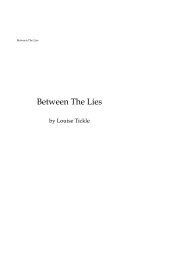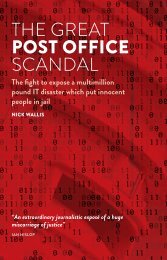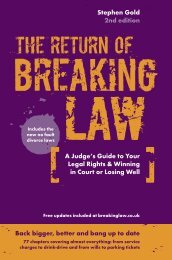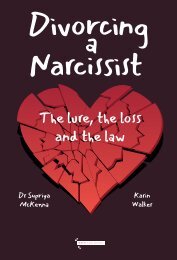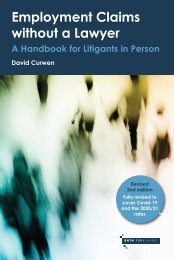Insolvency Made Clear: A Guide for Debtors
Plain English, practical guidance for anyone facing demands over a debt they are struggling to pay.
Plain English, practical guidance for anyone facing demands over a debt they are struggling to pay.
Create successful ePaper yourself
Turn your PDF publications into a flip-book with our unique Google optimized e-Paper software.
Introduction and aim of this book<br />
This book is <strong>for</strong> individuals who are facing bankruptcy and those whose companies<br />
are facing insolvency.<br />
The book is divided into six parts. Part 1 deals with individual bankruptcy and<br />
what happens to the bankrupt and their families during the bankruptcy; Part 2<br />
covers the equivalent process when companies go insolvent; Part 3 focuses on<br />
how to appeal a decision of the court; Part 4 explains how costs may be awarded<br />
against parties in different situations; Part 5 provides in<strong>for</strong>mation on how best<br />
to use a lawyer if resources are limited, and litigation tips if the debtor has to<br />
represent themselves; and finally, Part 6 consists of two annexes which contain<br />
model documents and checklists. These documents and checklists are also available<br />
as text documents so the reader can amend the templates as they wish (the<br />
files are provided within the digital download pack).<br />
Part of the difficulty people face when having problems with debt are technical<br />
terms used without an explanation. ‘<strong>Insolvency</strong>’ is the word used when a person<br />
or a company has more debt than assets; or who/which cannot pay a debt which<br />
has fallen due. If that someone is a person, this can lead to them going bankrupt.<br />
Bankruptcy is a court process where a stranger, the ‘Trustee in Bankruptcy’,<br />
takes control of the financial affairs of the bankrupt, selling most of the available<br />
assets to pay off the creditors. ‘Bankruptcy’ can be used loosely to mean<br />
‘insolvency’, or precisely to refer to the court process where a bankruptcy order<br />
is made. This book tries to find a balance between using the correct legal terms<br />
– which are essential to understand since they will be the words used in court<br />
and in legal documents – and being comprehensible.<br />
Bankruptcy is not the only insolvency process an individual can enter: see<br />
Chapter 1. The processes <strong>for</strong> a company are different and are set out in Chapter 13.<br />
For some, bankruptcy is a way to escape debts and start again. How to do this<br />
voluntarily is explained in Paragraph 3.3. Others look <strong>for</strong> an alternative. Chapter<br />
3 also discusses when to contest and when not to contest the making of a bankruptcy<br />
order.<br />
xxix



